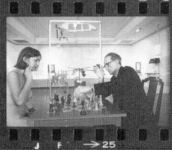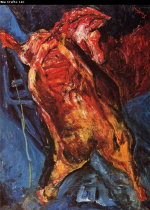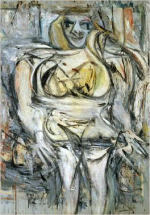I think of those types of artists as kitschy too. Like that guy who does those mediocre paintings then puts a blue dog in them.Ah, my bad. Wrong "artiste". Yes, Kinkade is as you describe. I was thinking of the guy who put lots of wide eyed things on black canvas. Ooops, woman. Here's an example among 1,354,287 similar pieces.

What Makes a Great Work of Art?
- Thread starter cosmicfolklore
- Start date
You are using an out of date browser. It may not display this or other websites correctly.
You should upgrade or use an alternative browser.
You should upgrade or use an alternative browser.
SmokingPipes.com Updates
Watch for Updates Twice a Week
What about fountain by Marcel Duchamp ?

Or even better “artist’s shit” by Piero Manzoni (he canned his own shit , museum had to remove it cause it leaked)

« it’s because you don’t understand art bruh» some recall ?
I might be old fashioned for my age , i prefer Talent but then again everyone its own i guess , I’ll pass on the dadaism and nihilist “art”

Or even better “artist’s shit” by Piero Manzoni (he canned his own shit , museum had to remove it cause it leaked)

« it’s because you don’t understand art bruh» some recall ?
I might be old fashioned for my age , i prefer Talent but then again everyone its own i guess , I’ll pass on the dadaism and nihilist “art”
You'd have to know the full story about why a painter, printmaker, and photographer would have put a urinal in a gallery.What about fountain by Marcel Duchamp ?
This was a joke he was playing on the art world. At the time, galleries were like exclusive clubs that you had to do everything their way before you could sell you work. In an exhibit of Parisian Salon des Indépendants he put this on a stand, titled it "Fountain" and signed it R. Mutt, which is double entendre, and completing Marcel's middle finger in the face of the pretentious art world, and telling them all to drink his piss.
Sometimes art can be just a political statement to "The Man."
I mean, no one wants this in their house, but I can respect the gesture.
He surely fit my description of what art is and great work ,as im talking about it and give me emotions(not good one but still emotions) it was a bold move thats for sure and I’m not saying these type of work shouldn’t exist but i don’t like when i go to the museum and got the feeling i am into a junkyard .You'd have to know the full story about why a painter, printmaker, and photographer would have put a urinal in a gallery.
This was a joke he was playing on the art world. At the time, galleries were like exclusive clubs that you had to do everything their way before you could sell you work. In an exhibit of Parisian Salon des Indépendants he put this on a stand, titled it "Fountain" and signed it R. Mutt, which is double entendre, and completing Marcel's middle finger in the face of the pretentious art world, and telling them all to drink his piss.
Sometimes art can be just a political statement to "The Man."
I mean, no one wants this in their house, but I can respect the gesture.
True, and I find explanations that these stick up the ass art curators put on the walls, don't always help the casual visitor relate to the stuff they are looking at. This is my chief criticism to most museums I visit.He surely fit my description of what art is and great work ,as im talking about it and give me emotions(not good one but still emotions) it was a bold move thats for sure and I’m not saying these type of work shouldn’t exist but i don’t like when i go to the museum and got the feeling i am into a junkyard .
I am pretty sure that loading many museums down with unexplained garbage is what has helped lead us into artists making even more obscure junk garbage.
But, Marcel Duchamp won my heart in art history when I learned that he stopped making actual art and spent the last days of his life playing chess with nude super models in gallery windows where the general public could watch them. I applaud that.

I like the people in the background laughing at her. Come on really? Are you suppose to take that seriously. Sorry if I offended any Yoko enthusiasts.The truth, I am somewhat confused.............It will be that I do not understand modern art
A lot of folks would disagree with that.Art shuld be beautiful
I would agree that it doesn't have to be beautiful to be art...but that doesn't negate the fact that there are objective standards of beauty.The thing about "beauty" is that everyone defines this differently...
View attachment 206425
So, if it's not beautiful to you, but is for someone else... is it not art?
If someone thinks something is beautiful when it obviously isn't, it's just their personal problem.
If someone thinks something is beautiful when it obviously isn't, it's just their personal problem.
While I think that you are just having a bit of fun. This was my area of my specialization. Everyone does have different standards for beauty. If everyone just had one standard, the human race would have died out long ago.
Professors of art as well as professional art critics make art overly difficult to appreciate, understand, and enjoy.
Here is my simple criteria for what is art as well as whether it is successful.
1. Art is a media used by a person to communicate an idea, emotion, or a thought or a set of thoughts by engaging either the passive or active observer. Art is successful if the observer is able to engage in such a way as to understand or be emotionally moved by the art work. Art can be sound, words, physical media, or all of the above. It is successful if the intended message or emotion intended by the artist is understood by the observer. The measure of success in communicating the ideas is one measure of an artist's skills as an artist. Cave paintings, where almost all measure or understanding of the artist's intent or the context of the culture of the artist has been lost to the viewer, still are successful as measured by the emotional reaction of the observer. Even though the exact message has been lost to time, the emotions of wonder and awe remain. It is clear that this was one intent of the artist.
2. Art is NOT someone taking a dump in the middle of the desert. That is excrement. However, even if the purpose of the excrement was to intentionally construct "something" with the intent of communicating a message, the overwhelming revulsion of the "project" would nullify any artistic merit that might have been sought by the artist. There are other, less harmful ways to communicate a political, social, or ecological message and regardless, the success of such an endeavor would likely fail to communicate the intended message.
3. Which brings me to my last point, the artist is communicating. They have an audience. We measure the greatness of art by how readily the art can communicate to numbers of people, both now and in the future. Art with a finite audience or art that "is in the moment" tends to be forgotten and relegated to the interest of historians. It doesn't mean it wasn't art, but its success as art is easily forgotten or lost to time.
There are reasons why timeless art is often that art that has elements of beauty. How is that the Rape of the Sabines is represented in many artworks and still holds up as beautiful, even when it is communicating something that was horrific both then and now? There is a timelessness to the art, a level of skill, and a sense of workmanship that our minds perceive as beautiful. It is the combination of all these elements that work together to create a sense of beauty.
One last thing. If art requires a lengthy explanation by an "expert" in order to be appreciated, it seems to me that the artist has failed to communicate and that the art is indeed lacking in some essential quality. There should be little to NO "filters" between the artist, the art, and the observer.
Just my two cents.
Here is my simple criteria for what is art as well as whether it is successful.
1. Art is a media used by a person to communicate an idea, emotion, or a thought or a set of thoughts by engaging either the passive or active observer. Art is successful if the observer is able to engage in such a way as to understand or be emotionally moved by the art work. Art can be sound, words, physical media, or all of the above. It is successful if the intended message or emotion intended by the artist is understood by the observer. The measure of success in communicating the ideas is one measure of an artist's skills as an artist. Cave paintings, where almost all measure or understanding of the artist's intent or the context of the culture of the artist has been lost to the viewer, still are successful as measured by the emotional reaction of the observer. Even though the exact message has been lost to time, the emotions of wonder and awe remain. It is clear that this was one intent of the artist.
2. Art is NOT someone taking a dump in the middle of the desert. That is excrement. However, even if the purpose of the excrement was to intentionally construct "something" with the intent of communicating a message, the overwhelming revulsion of the "project" would nullify any artistic merit that might have been sought by the artist. There are other, less harmful ways to communicate a political, social, or ecological message and regardless, the success of such an endeavor would likely fail to communicate the intended message.
3. Which brings me to my last point, the artist is communicating. They have an audience. We measure the greatness of art by how readily the art can communicate to numbers of people, both now and in the future. Art with a finite audience or art that "is in the moment" tends to be forgotten and relegated to the interest of historians. It doesn't mean it wasn't art, but its success as art is easily forgotten or lost to time.
There are reasons why timeless art is often that art that has elements of beauty. How is that the Rape of the Sabines is represented in many artworks and still holds up as beautiful, even when it is communicating something that was horrific both then and now? There is a timelessness to the art, a level of skill, and a sense of workmanship that our minds perceive as beautiful. It is the combination of all these elements that work together to create a sense of beauty.
One last thing. If art requires a lengthy explanation by an "expert" in order to be appreciated, it seems to me that the artist has failed to communicate and that the art is indeed lacking in some essential quality. There should be little to NO "filters" between the artist, the art, and the observer.
Just my two cents.
Actually, I think you've made it more difficult and rather snobbish. "You" think that taking a dump in the middle of the street is not art, while maybe someone else might. You are dictating what someone else MAY think is art. It is perfectly fine for you to not think it is art (I don't either) but, I am not going to dictate what others may believe to be art.Professors of art as well as professional art critics make art overly difficult to appreciate, understand, and enjoy.
Here is my simple criteria for what is art as well as whether it is successful.
1. Art is a media used by a person to communicate an idea, emotion, or a thought or a set of thoughts by engaging either the passive or active observer. Art is successful if the observer is able to engage in such a way as to understand or be emotionally moved by the art work. Art can be sound, words, physical media, or all of the above. It is successful if the intended message or emotion intended by the artist is understood by the observer. The measure of success in communicating the ideas is one measure of an artist's skills as an artist. Cave paintings, where almost all measure or understanding of the artist's intent or the context of the culture of the artist has been lost to the viewer, still are successful as measured by the emotional reaction of the observer. Even though the exact message has been lost to time, the emotions of wonder and awe remain. It is clear that this was one intent of the artist.
2. Art is NOT someone taking a dump in the middle of the desert. That is excrement. However, even if the purpose of the excrement was to intentionally construct "something" with the intent of communicating a message, the overwhelming revulsion of the "project" would nullify any artistic merit that might have been sought by the artist. There are other, less harmful ways to communicate a political, social, or ecological message and regardless, the success of such an endeavor would likely fail to communicate the intended message.
3. Which brings me to my last point, the artist is communicating. They have an audience. We measure the greatness of art by how readily the art can communicate to numbers of people, both now and in the future. Art with a finite audience or art that "is in the moment" tends to be forgotten and relegated to the interest of historians. It doesn't mean it wasn't art, but its success as art is easily forgotten or lost to time.
There are reasons why timeless art is often that art that has elements of beauty. How is that the Rape of the Sabines is represented in many artworks and still holds up as beautiful, even when it is communicating something that was horrific both then and now? There is a timelessness to the art, a level of skill, and a sense of workmanship that our minds perceive as beautiful. It is the combination of all these elements that work together to create a sense of beauty.
One last thing. If art requires a lengthy explanation by an "expert" in order to be appreciated, it seems to me that the artist has failed to communicate and that the art is indeed lacking in some essential quality. There should be little to NO "filters" between the artist, the art, and the observer.
Just my two cents.
As a once professor of Art and Aesthetics, I think it is all rather simple. Art is something crafted where a phenomena has occurred in the creative process by the hand of the maker that elevates the thing created above the level of ordinary. And, each person has a set of aesthetics that acts as a measuring stick by which we all recognize the art based on our age, gender, race, socio economic background, region, and life experiences.
I was having a little bit of fun with the last sentence...but I'm partly serious as well. I of course understand there is some subjectivity, and a range of what could be considered beauty...and not everyone is going to agree or have the same taste. But I still would assert that some things can be objectively not beautiful...that it's possible to be far enough outside of the subjective range that if someone tries to label it as beauty there is a problem there.While I think that you are just having a bit of fun. This was my area of my specialization. Everyone does have different standards for beauty. If everyone just had one standard, the human race would have died out long ago.
Hmmm... I have seen some really damn ugly people that seem to love and admire each other. Maybe even a few forum members that look like something genetically went haywire... but, Someone loves them and thinks their beautiful.that it's possible to be far enough outside of the subjective range that if someone tries to label it as beauty there is a problem there.
I like to think that God wouldn't make someone who can't be admired as beautiful by someone.
You're projecting something onto my comments that aren't there.Hmmm... I have seen some really damn ugly people that seem to love and admire each other. Maybe even a few forum members that look like something genetically went haywire... but, Someone loves them and thinks their beautiful.
I like to think that God wouldn't make someone who can't be admired as beautiful by someone.
For starters, I thought we were talking about works of art. I don't consider human beings to be in that category...along with the complexities of human relationships...as well as qualities of inner beauty. There is much that can be said about all of that, but entirely unrelated to my comments.
Ahhh... Yes... well, I was taking the discussion to the next level, and skipping some modifiers, haha.You're projecting something onto my comments that aren't there.
For starters, I thought we were talking about works of art. I don't consider human beings to be in that category...along with the complexities of human relationships...as well as qualities of inner beauty. There is much that can be said about all of that, but entirely unrelated to my comments.
So, taking movies as art... I for one am disgusted by all horror movies. I see no value in them. I want to say that anyone who likes movies like that has mental issues that I just don't understand. However, enough people seem to like them and are attracted to that disgusting genre that it makes me pause.
Also, Death metal... what sort of sick human listens to that on purpose... but yet... it is a huge industry.
Art... some people are attracted to weird things.
Ok, now that we're on the same subject, I'd say horror movies and death metal can (potentially at least) be art, and someone can appreciate them for that...but they're not beauty.Ahhh... Yes... well, I was taking the discussion to the next level, and skipping some modifiers, haha.
So, taking movies as art... I for one am disgusted by all horror movies. I see no value in them. I want to say that anyone who likes movies like that has mental issues that I just don't understand. However, enough people seem to like them and are attracted to that disgusting genre that it makes me pause.
Also, Death metal... what sort of sick human listens to that on purpose... but yet... it is a huge industry.
Art... some people are attracted to weird things.
Some people may think so. For example, I really like Miles Davis's On the Corner, and I think it's beautiful; however, I totally understand if someone else doesn't, because it is rather chaotic until you start to realize the way the sounds and notes start to play together.Ok, now that we're on the same subject, I'd say horror movies and death metal can (potentially at least) be art, and someone can appreciate them for that...but they're not beauty.
There was a group of Germanic painters who were exploring this issue back in the 20's. The color red is such a hard color to get right on the canvas. They chose a subject matter that is thought top be disgusting by most, but the way they handled the color was beautiful. So, the subject matter may not be beautiful to most of us, the handling of the material can be. Beauty is in the eye of the beholder. And, definitely, there is someone on this planet that thionks that raw meat is beautiful.









